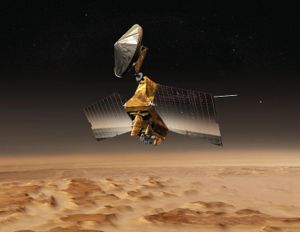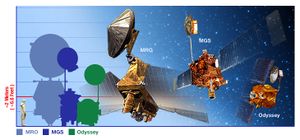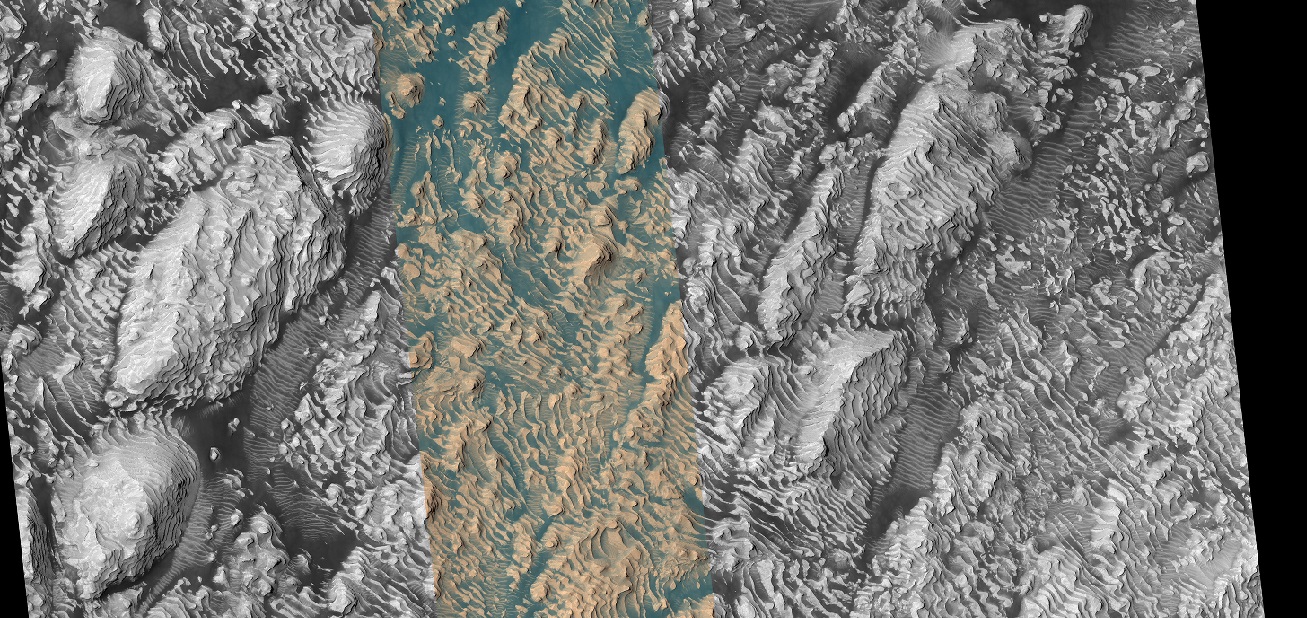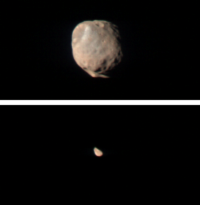Difference between revisions of "Mars Reconnaissance Orbiter"
(→High Resolution Imaging Science Experiment: added image) |
|||
| Line 34: | Line 34: | ||
==High Resolution Imaging Science Experiment== | ==High Resolution Imaging Science Experiment== | ||
| − | The orbiting satellite is making this possible through the use of some of the most advanced optics available to modern spacecraft. The ''High Resolution Imaging Science Experiment'' (''HiRISE'') is investigating the | + | The orbiting satellite is making this possible through the use of some of the most advanced optics available to modern spacecraft. The ''High Resolution Imaging Science Experiment'' (''HiRISE'') is investigating the geology of Mars to identify deposits that are a result of climatic and geologic processes. This new, high resolution approach will aid future landing sites for robotic and manned missions to the Red Planet. Current resolution capabilities can produce images of features of less than 1 meter. For high priority targets, a stereo method can be applied so features of 25 cm can be imaged.<ref>[http://marsoweb.nas.nasa.gov/HiRISE/ HiRISE homepage]</ref> Each image has a central band that is in color. The colors are not the same as we would see, however. Scientists used colors that will help them identify minerals. |
<gallery class="center" widths="190px" heights="180px" > | <gallery class="center" widths="190px" heights="180px" > | ||
Revision as of 13:59, 6 September 2019
Launched on August 12, 2005 by an Atlas V rocket from Cape Canaveral Air Force Station, the Mars Reconnaissance Orbiter (MRO) carrying HiRISE and other instruments arrived at Mars on March 10, 2006. However, it did not begin its main picture taking until November 2006. A long The NASA mission began taking data in November 2006 after completion of a long aerobreaking maneuver in the upper Mars atmosphere to place it in the desired orbit. The orbit has an inclination of 93 degrees, which means it orbits north and south in a polar orbit, as the planet turns beneath it.[1] As a result of the characteristics of its orbit, HiRISE takes pictures at about 3 p.m. local time. This time frame produces few shadows, but does avoid morning mist. To arrange for communications support during the arrival of the InSight Mars lander mission, the orbit was slightly modified on September 28, 2016 by a 75 second engine burn. [2] [3]
Mars Reconnaissance Orbiter is powered by two large solar panels give MRO a wingspan the length of a school bus that can produce about 2,000 watts of electricity. Its main antenna is a 10 feet (3 meters) diameter dish. The total science data sent to Earth from MRO (264 terabits)is greater than all other interplanetary missions combined, past and present.[4]
Along with Mars Odyssey, MRO relays data from spacecraft on Mars' surface to NASA Deep Space Network antennas on Earth; consequently much more data can be sent to Earth.[5]
Contents
Orbit adjustments
MRO took seven and a half months to reach Mars. Although four trajectory corrections were planned and an additional fifth emergency maneuver was a possible, only three trajectory correction maneuvers were used. This saved 60|lbs fuel that would be usable during MRO's extended mission.[6] [7]
The craft approached Mars on March 10, 2006, and passing above its southern hemisphere at an altitude of 370-400km. All six of MRO's main engines burned for 27 minutes to slow the probe from 2900 to 1900 m/s. The initial orbit was a highly elliptical polar orbit with a period of about 35.5 hours.[8] Soon after insertion, the periapsis – the point in the orbit closest to Mars – was 426 km from the surface.[9] The apoapsis – the point in the orbit farthest from Mars – was 44,500 km from the surface.
In the movie, "2010: The Year We Make Contact" a type of aerobraking was used to enter orbit around Jupiter. Aerobraking has the potential to allow us to send more useful payloads to planets like Mars. It was successfully used to adjust the orbit of the Mars Reconnaissance Orbiter, as is described below.
Aerobraking began on March 30, 2006. This three-step process only needed half the fuel to reach a lower, more circular orbit with a shorter period. During its first five orbits of the planet (one Earth week), MRO fired its thrusters to lower the periapsis of its orbit into correct aerobraking altitude. This altitude varies with the thickness of the atmosphere which changes with the seasons. Next, MRO maintained aerobraking altitude for 445 planetary orbits (about five Earth months) by employing its rocket thrusters. Scientists did not want to heat the spacecraft too much, but they still wanted to slow the craft down. By dipping into the atmosphere, drag slowed the craft. As the speed was reduced by the atmosphere at the low point in the orbit, the high point (apoapsis) in the orbit fell as well. After correct apoapsis altitude was obtained, MRO used its thrusters to move its periapsis out of the edge of the Martian atmosphere.[10][11]
In September 2006 MRO fired its thrusters twice more to fine-tune its final, nearly circular orbit to approximately 250 to 31 km above the Martian surface, with a period of about 112 minutes.[12] [13] The SHARAD radar antennas were deployed on September 16. All of the scientific instruments were tested and most were turned off prior to the solar conjunction that occurred from October 7 to November 6, 2006. After the conjunction ended the "primary science phase" began. During solar conjunction, Mars is in direct line with the sun; hence signals can get garbled at that time. Usually, commands are not sent to spacecraft on or near Mars at that time.
Science goals and instrumentation
The MRO is intended to contribute to the four main areas outlined by NASA's Mars Exploration Program.
- Determine whether life ever arose on Mars
- Characterize the climate of Mars
- Characterize the geology of Mars
- Prepare for human exploration
High Resolution Imaging Science Experiment
The orbiting satellite is making this possible through the use of some of the most advanced optics available to modern spacecraft. The High Resolution Imaging Science Experiment (HiRISE) is investigating the geology of Mars to identify deposits that are a result of climatic and geologic processes. This new, high resolution approach will aid future landing sites for robotic and manned missions to the Red Planet. Current resolution capabilities can produce images of features of less than 1 meter. For high priority targets, a stereo method can be applied so features of 25 cm can be imaged.[14] Each image has a central band that is in color. The colors are not the same as we would see, however. Scientists used colors that will help them identify minerals.
Wide view of layers in Danielson Crater The center band is in color.
CTX camera
The Context Camera (CTX) yields images with a pixel resolution up to about 6 m. CTX is used to produce context maps for observations of HiRISE and CRISM, and to provide mosaics of large regions, monitor places for changes over time, and acquire stereo (3D) coverage of special regions and potential future landing sites.[15] [16] The optics of CTX consist of a 350 mm focal length Maksutov–Cassegrain Reflector telescope with a 5,064 pixel wide line array. The instrument takes pictures 30 km wide and has sufficient memory to store an image 160 km long.[17] The camera was built, and is operated by Malin Space Science Systems. CTX mapped 50% of Mars by February 2010.[18] On the 10th anniversary of MRO (March 9, 2016), NASA announced that The Context Camera (CTX), had taken pictures of more than 95 percent of Mars. In these images, objects smaller than a tennis court could be detected.[19]
CRISM
The Compact Reconnaissance Imaging Spectrometer for Mars (CRISM) is primarily used to detect any evidence for past and present traces of water through the analysis of minerals and geology. In particular is the objective to help locate Martian resources that could provide local support for eventual human exploration and colonization of Mars.[20] The most important of these is water. Managed by Johns Hopkins University Applied Physics Laboratory, Laurel, Maryland, the Compact Reconnaissance Imaging Spectrometer (CRISM), has imaged nearly 98 percent of the planet in multiple visual-light and infrared wavelengths; hence, it have told us of the surface composition at scales of 100 to 200 yards or meters per pixel.[21]
Mars Climate Sounder
In an effort to characterize the 4 dimensional dynamics of the Mars atmosphere (3 spatial dimensions and time), the Mars Climate Sounder (MCS) is used to acquire profiles of the lower 50 miles of the atmosphere, including clouds, dust, pressure and temperature.[22] It is a spectrometer with one visible/near infrared channel (0.3 to 3.0 μm) and eight far infrared channels selected for the purpose.[23]
References:
- ↑ Lyons, Daniel T. (August 5–8, 2002). "MARS RECONNAISSANCE ORBITER: AEROBRAKING REFERENCE TRAJECTORY" (PDF). AIAA/AAS Astrodynamics Specialist Conference and Exhibit. Archived from the original (PDF) on October 18, 2011. Retrieved March 9, 2012.
- ↑ NASA Mars Orbiter Preparing for Mars Lander's 2016 Arrival
- ↑ Mars orbiter prepares for next year's InSight lander arrival. July 29, 2015.
- ↑ https://mars.nasa.gov/news/ten-years-of-discovery-by-mars-reconnaissance-orbiter/
- ↑ https://mars.nasa.gov/news/ten-years-of-discovery-by-mars-reconnaissance-orbiter/
- ↑ https://www.nytimes.com/2006/03/11/science/11plane.html?ex=1299733200&en=2edeb45e31198f5e&ei=5089&partner=rssyahoo&emc=rss
- ↑ https://web.archive.org/web/20060410145133/http://mars.jpl.nasa.gov/mro/mission/orbiter_update.html
- ↑ https://www.space.com/2175-mars-orbiter-ready-action.html
- ↑ https://www.space.com/2175-mars-orbiter-ready-action.html
- ↑ http://mars.jpl.nasa.gov/mro/mission/tl_aerobraking.html
- ↑ https://www.space.com/2824-mars-orbiter-successfully-big-burn.html
- ↑ https://mars.jpl.nasa.gov/mro/newsroom/pressreleases/20060912a.html
- ↑ https://www.webcitation.org/6EE9oKZFn?url=http://airandspace.si.edu/research/ceps/cepsicons/highlights/fact_sheet_front.pdf
- ↑ HiRISE homepage
- ↑ Malin, M. C.; et al. (2007). "Context Camera Investigation on board the Mars Reconnaissance Orbiter". Journal of Geophysical Research. 112 (E05S04): 1–25. Bibcode:2007JGRE..112.5S04M. doi:10.1029/2006je002808.
- ↑ Harrison, Tanya N.; Malin, Michael C.; Edgett, Kenneth S. (2009). "Present-day activity, monitoring, and documentation of gullies with the Mars Reconnaissance Orbiter (MRO) Context Camera (CTX)". Geological Society of America Abstracts with Programs. 41 (7): 267. Bibcode:2009GSAA...41..267H.
- ↑ http://www.msss.com/mro/ctx/ctx_description.html
- ↑ http://www.msss.com/all_projects/mro-ctx.php
- ↑ https://mars.nasa.gov/news/ten-years-of-discovery-by-mars-reconnaissance-orbiter/
- ↑ CRISM homepage
- ↑ https://mars.nasa.gov/news/ten-years-of-discovery-by-mars-reconnaissance-orbiter/
- ↑ MCS homepage
- ↑ http://mars.jpl.nasa.gov/mro/mission/sc_instru_mcs.html












